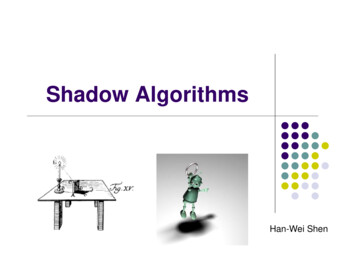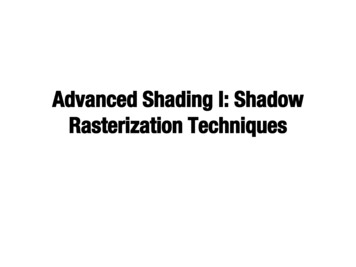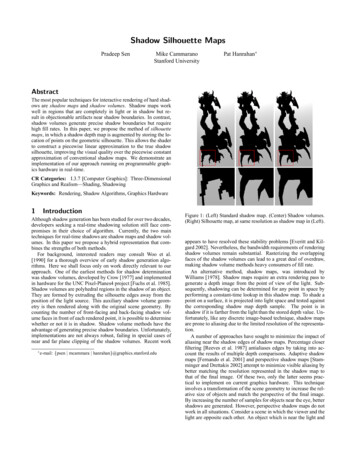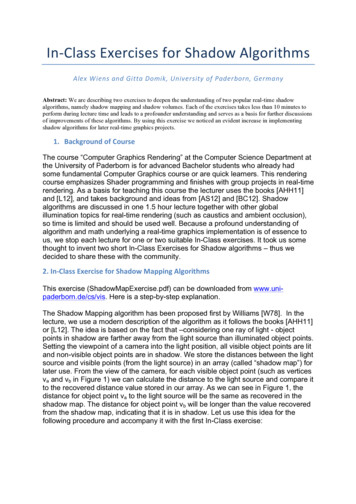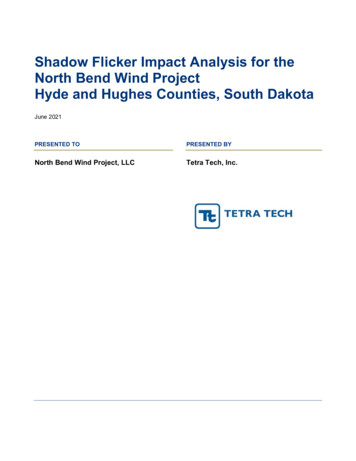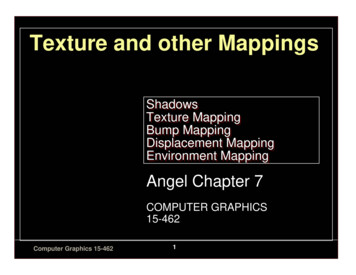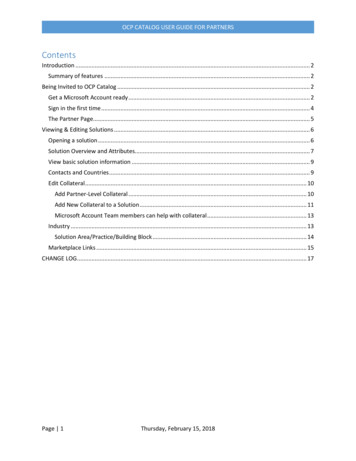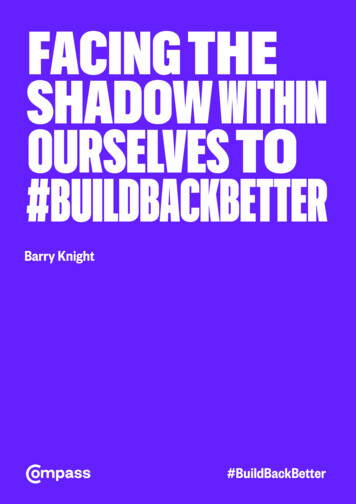
Transcription
FACING THESHADOW WITHINOURSELVES TO#BUILDBACKBETTERBarry Knight#BuildBackBetter
Published July 2020 by CompassBy Barry KnightAbout the author:Barry Knight is a social scientist and statistician who, over a longcareer, has worked in many fields both in the UK and internationally. Heis also a member of the Compass Board. CompassAll rights reserved. Except for the quotation of short passages forthe purpose of criticism or review, no part of this publication may bereproduced, stored in a retrievable system, or transmitted, in any formor by any means, electronic, mechanical, photocopying, recording orotherwise, without the prior permission of Compass.2Facing the Shadow Within Ourselves
Please get in touch, join,support and work with us.Write to us at Freepost CompassEmail us at info@compassonline.org.ukYou can follow us on Twitter@CompassOfficeTo find out more about Compass,please visit our website:www.compassonline.org.uk/joinAbout CompassCompass is platform for a good society, a world that is much moreequal, sustainable and democratic. We build networks of ideas, partiesand organisations to help make systemic change happen. Our strategicfocus is to understand, build, support and accelerate new forms ofdemocratic practice and collaborative action that are taking place incivil society and the economy, and to link that up with state reformsand policy. The meeting point of emerging horizontal participation andvertical resources and policy we call 45 Change. The question we aretrying to help solve, as we endeavour to #BuildBackBetter, is not justwhat sort of society we want, but, increasingly, how to make it happen?3Facing the Shadow Within Ourselves
The air is thick with chickens coming home to roost. Problems wehave ignored for too long are landing one by one – first the pandemic,second the economic collapse and third the race crisis. Next, we willfeel the full force of the climate emergency.We humans are not built to deal with such rapid change. Half a centuryago, Alvin Toffler coined the phrase ‘future shock’, which he defined as‘too much change in too short a period of time’.1 It’s as if we’ve beenliving in a kaleidoscope. No sooner does one chicken land, then another,and then another.It is small wonder that people feel out-of-sorts. Having talked in depthwith around 100 people over the past three months, almost everyoneexpresses an underlying sense of unease, feeling oddly disconnectedand searching for something that makes sense. In #BuildBackBetter,written at the beginning of the lockdown, I suggested that this wasdue to having entered the limen – an ambiguous zone of radical changedestroying our frameworks, causing feelings of panic, fear, loss andconfusion, and yet with no clear light at the end of the tunnel.While such confusion may be uncomfortable, it may also presage anew world. The lockdown has given people an opportunity to considerthings we don’t normally talk about – who we are in the world, how weconstruct meaning, and what we can draw from our current crisesand predicaments to find a new future that resonates more with us ashuman beings living in a natural ecosystem, rather than as machines inservice to an economy that has come to diminish our humanity.How can we avoid going back to the pre-crisisworld?At the beginning of the lockdown, French philosopher and anthropologist Bruno Latour asked: ‘What protective measures can you think of sowe don’t go back to the pre-crisis production model?’ In a recent interview, he was asked why this exercise resonated all over the world. Hereplied:‘Even if you were not a spiritual person, the lockdown forcedeveryone into a kind of retreat, a moment for reflection. It wasquite extraordinary. The questions were therapeutic. They gavepeople powerlessly stuck at home a way of thinking about howthey would create a better future.’The desire for a new world is shown in the spread of the #BuildBackBetter hashtag, which has achieved exponential popularity, becoming ameme for many different people and organisations who see the crisis asoffering new possibilities for humanity if we can seize the moment.4Facing the Shadow Within Ourselves
It also shows that change can and does happen very fast. As Latourexplains:‘Covid has given us a model of contamination. It has shown howquickly something can become global just by going from one mouthto another. That’s an incredible demonstration of network theory It shows that we must not think of the personal and the collective as two distinct levels. The big climate questions can make individuals feel small and impotent. But the virus gives us a lesson. Ifyou spread from one mouth to another, you can viralise the worldvery fast.’This is exciting, and suggests that we could have a new and betterworld soon – in line with Malcolm Gladwell’s ‘tipping point’. The fact thatCompass has developed a range of themes to #BuildBackBetter andto galvanise more than 350 organisations to support a series of policyrecommendations is highly encouraging.The dangers of false certaintyAt the same time, as the hashtag has become a meme, and spread widely into all sorts of unlikely places, there are dangers. While memes canbe thought of as cognitive versions of viruses, carrying cultural ideas,symbols or practices transmitted from one mind to another, their lackof specific and fully formed normative content means that they areopen to a variety of interpretations and can therefore be misused. Toput this another way, the #BuildBackBetter meme has hitched itselfto all sorts of partly formed propositions that bear no relation to oneanother nor any connection with a coherent theme that will enable us tofind a way through the mess that we find ourselves in. For some, this is akind of land grab– a way of legitimising a pre-existing point of view of theworld. Views are being put forward as if they are certain to solve ourproblems, yet the truth is that they are mostly untested.Such false certainty is an enemy. As a saying often attributed to MarkTwain puts it:‘It ain’t what you know that gets you into trouble. It’s what youknow for sure that just ain’t so.’False certainty is breeding an atmosphere of intolerance of other opinions that is driving a culture of hate in public discourse. We would dowell to remember that certainty is a quality beyond the reach of humanbeings. Commenting on the uncertainty principle in physics, biologist J.B. S. Haldane noted:‘Now my own suspicion is that the Universe is not only queererthan we suppose, but queerer than we can suppose.’25Facing the Shadow Within Ourselves
Turning from science to poetry, Robert Graves speaks to such uncertainty in his In Broken Images. The final two stanzas are:‘He continues quick and dull in his clear images;I continue slow and sharp in my broken images.He in a new confusion of his understanding;I in a new understanding of my confusion.’Facing the pain of problemsRushing to the wrong conclusion will do more harm than good. In contemplating the necessary changes in our psyche, we need time. We mustgo deeper, perhaps facing the secular equivalent of the ‘dark night ofthe soul’ to change our mental models. In The Road Less Travelled,Scott Peck draws on his work as a psychiatrist to show that facing thepain of problems is the only authentic way of finding meaning in life, yetmost people avoid this pain. The book shows that there are techniquesof suffering that enable the pain of problems to be worked through andsystematically solved. Without facing what we need to, we live in a superficial and meaningless world, allowing problems to grow beneath ourfeet without realising it. And then, the chickens come home to roost.As Donella Meadows, lead author of Limits to Growth, pointed out half acentury ago, deep change depends on new ways of seeing. To interveneeffectively in a system, the most difficult and ultimately most effectivepoint of intervention is to shift the mindsets and paradigms that underlie behaviour. These are the most deeply held beliefs that drive a systemor were used to design it.The systems icebergTo get at the roots of problems, systems theory uses the ‘systems iceberg’. First developed by Edward T Hall in 1976, this looks at how various elements within a system – which could be an ecosystem, an organisation, or something more dispersed such as a supply chain – influenceone another.3 Rather than reacting to individual problems that arise, asystems thinker will investigate relationships between activities withinthe system, look for patterns over time, and identify root causes.The iceberg is a useful metaphor because it has only 10 per cent of itstotal mass above the water while 90 per cent is underwater. But that90 per cent is what the ocean currents act on, and what creates theiceberg’s behaviour at its tip. Global issues can be viewed in the sameway.6Facing the Shadow Within Ourselves
The iceberg model typically has four categories. Above the waterlineare ‘events’. Here, to take an example from the field of poverty, a recentevent is a news item reporting an 81 per cent increase for emergencyfood parcels from food banks during the last two weeks of March 2020.The next level down is ‘patterns and trends’. Looking below the surface,we find an exponential rise in the use of food banks over the past tenyears. Further down, we find ‘structures and behaviours’, and see thatausterity regimes began in 2010 and Universal Credit was introducedduring this period. At the bottom, we find mental models and worldviews. At this level, we find widespread hostility towards people in receipt of social security payments and a view that people in poverty havemade bad choices that mean the state should not look after them.What lies at the bottom of the systems iceberg is of critical importanceto what happens in the system. This is because of what cognitive scientists call the ladder of inference: the way that mental models affect theway that we take decisions about action in the world.Starting at the bottom of the ladder, we have reality and facts. Fromthere, we: Experience these selectively based on our beliefs and prior experience Interpret what they mean Apply our existing assumptions, sometimes without consideringthem Draw conclusions based on the interpreted facts and our assumptions7Facing the Shadow Within Ourselves
Develop beliefs based on these conclusions Take actions that seem ‘right’ because theyare based on what we believeThis can create a vicious circle. Our beliefshave a big effect on how we select from reality,and can lead us to ignore the facts altogether.Soon we are literally jumping to conclusions –by missing facts and skipping steps in the reasoning process. In his book Thinking, Fast andSlow, Daniel Kahneman summarises decades ofresearch conducted with Amos Tversky thatdemonstrates the systematic biases and errorsin the way that humans think.The limited utility of rationalityRationality has limited utility in public life because people are not rational. It is what liesdeep in our psyche that matters. Conservativepoliticians have understood this very well. Two years after her 1979victory, Margaret Thatcher gave an interview to the Sunday Times inwhich she said:‘Economics are the method: the object is to change the soul.’Contrast this with the behaviour of Labour governments’ policies towards poverty between 1997 and 2010. In Decent Childhoods, which reviews Labour’s performance, Kate Bell and Jason Strelitz showed thatLabour’s anti-poverty politics had been introduced by stealth and haddone little to engage the public, so were easily reversed when Labourlost power. As Selina Todd showed in her history of the working class,generations who had grown up in the 1980s and 1990s had absorbed theneoliberal ethic that people are responsible for their circumstances.4It is pointless to develop policies and programmes in a society that runcounter to the underlying values and culture of that society and expectthem to stick.During a recent Ariadne webinar, Naomi Klein described the failure ofprogressive thinking following the 2008 financial crisis:‘Neoliberalism has polluted our imagination, made collective actionsuspect.’While our underlying mindset is based on a philosophy that pays scantattention to human needs, policies and practices that are already in theOverton Window are most unlikely to meet the needs of a new and morehumane world.8Facing the Shadow Within Ourselves
A new moral imaginationAs John Paul Lederach says, we need a new moral imagination:‘The wellspring lies in our moral imagination, which I will define asthe capacity to imagine something rooted in the challenges of thereal world yet capable of giving birth to that which does not yetexist.’Ratiocination – the use of logic and evidence – is of little use here. Weneed to enter the realm of creativity and wonder. As my friend ColinGreer puts it, poetry helps because it ‘pushes us to the edge of wordsand beyond the limits of boundaries’. In response to an early draft of#BuildBackBetter, he sent me the draft of a poem subsequently published as Build Better:Hymn to the rhythms of Chariots of FireRefrain:Give me your soulIn gratitudeTear up your scarlet letterShare your soulIn certitudeWe can build better.No more chanteuses washed up in stormsNo babies burned in firesNo home a mere haven from diseaseBut a boundary on desire.No more caged hummingbirdsFlying north to mate with flowersNo distended skin and boneServed up for ginger givers.No rebuilding of the pastNo loose tile in the raftersNo hard boiled eggs atop of wallsNo cost saving disasters.No greed to weaken hardened steelFired up to build bridgesNo interest rates that maim and killBut souls grown bold enough to kneelAnd build better 9Facing the Shadow Within Ourselves
Refrain:Give me your soulIn gratitudeTear up your scarlet letterShare your soulIn certitudeWe can build better.For me, this poem takes us straight into what we need to do. It takesus into ‘soul work’. We need to go deep into the collective unconsciousand transform ourselves. This is not an airy-fairy process, but involvesintense work of self-examination proposed by serious writers includingCarl Jung, Alice Miller, Roberto Assagioli, James Hillman, Robert Bly,Robert A Johnson, Alan Watts and others.Addressing the shadowThe key to such work is to address ‘the shadow’. This is that part ofour personality that is incompatible with our chosen conscious attitudeabout ourselves. Every young child knows kindness, love and generosity,but children also quickly learn anger, selfishness and greed.These emotions are part of our shared experience. But as we grow up,traits associated with ‘being good’ are accepted, while others associated with ‘being bad’ are rejected. As poet Robert Bly says in A LittleBook of the Human Shadow, children are taught to put all of these unwanted parts into an invisible bag and drag it behind them.This rejected side becomes the shadow, the ‘dark side’ of our personality, because it consists chiefly of primitive, negative emotions andimpulses like rage, envy, greed, selfishness, desire, and the striving forpower.Not all shadow characteristics are negative but whatever we perceiveas inferior, evil or unacceptable becomes part of the shadow. In patriarchal societies, men may split off qualities such as compassion, vulnerability and empathy. For example, bell hooks points out that:‘ patriarchy demands from all males that they engage in actsof self-mutilation, that they kill off the emotional parts of themselves. If an individual is not successful in crippling himself, he cancount on patriarchal men to enact rituals of power that will assault his self-esteem.’I know this from personal experience. When I was young, a favourite uncle had a bad stroke, and it seemed he would die. On hearing the news,I burst into tears. My father reprimanded me sharply and told me topull myself together. In that moment, I felt like a tree being felled by an10Facing the Shadow Within Ourselves
axe. Over time, I repressed my emotional side and became a hard-edged,analytical person. It took me years of soul work to recover my shadowand begin to feel again. Despite loving my father, I did not cry when hedied and could not do so in the 30 years since – that is, until I wrote thissentence when, finally, in a huge and welcome release, the tears welledup inside me and poured down my face as the shadow found the light.Redemption at last! We can’t defeat the shadow, but instead have toface it and incorporate it into our personality. That way, we becomewhole and retrieve the parts we have split off through repression.Projecting the shadow on to othersRetrieving the shadow is difficult because itbecomes part of our unconscious so that wefail to see it. We invariably project the partswe disown within ourselves on to other people, objects, and the environment. Projectionand shadow go hand in hand. When someoneevokes an emotional charge in you, it’s a signthat you’re projecting a disowned qualityfrom your shadow on to this individual. Thisis Anna Freud’s mechanism of ego defencethat lies at the heart of stereotyping andscapegoating others, since we project on toothers a characteristic that we have disowned in ourselves. In research for Rethinking Poverty, we observed that people whoare on the edge of poverty are more likelythan others to demean people living on socialsecurity benefits as ‘scroungers’. As psychotherapist Alice Miller puts it in The Drama ofthe Gifted Child:‘Disregard for those who are smallerand weaker is the best defence against a breakthrough of one’sown feelings of helplessness ’5Ontological insecurity breeds the projection of hate.Carl Jung, who made extensive use of the shadow in his work, arguedthat scapegoating at a collective level has dangerous consequences forsociety. Those unwilling, or unable, to face up to their shadows are easyprey for collectivist movements which have ready-made scapegoats inthe form of political opponents, members of different ethnic groups orsocioeconomic classes. Scapegoating at the level of collectives, in otherwords projecting our problems on to groups of people who differ fromus, proves attractive for several reasons. It allows us to avoid the damage to our personal relationships which occurs when we use someone11Facing the Shadow Within Ourselves
close to us as a scapegoat. Furthermore, given that our interactionswith members of the scapegoated group are usually limited, we do notrisk awakening to the realisation that these people are not nearly likethe distorted image of them we hold in our psyche.Many of the world’s leaders are in the grip of their shadow and project it on to groups and countries that they see as enemies. In a recentWashington Post article I’ve seen dictators rise and fall, Salman Rushdienotes common characteristics of dictators:‘Extreme narcissism, detachment from reality, a fondness for sycophants and a distrust of truth-tellers, an obsession with how oneis publicly portrayed, a hatred of journalists and the temperamentof an out-of-control bulldozer ’Such characteristics, displaying the basest impulses of the collectiveshadow, produce greed, hatred and violence – which, when combinedwith command over weapons of mass destruction, threaten the entireworld.How to deal with this?How do we deal with this? The issues are so big and all-encompassingthat we can only feel overwhelmed.While I don’t know – and can’t know – the answer, I have an inkling thatopposing hatred head-on with hatred makes things worse. History suggests that when anger and hate is met with anger and hate, it produceseven more anger and hate. Twitter spats, angry exchanges in Parliament, and tit-for-tat killings in violent conflicts all feed the cycle. Inbinary conflicts, the shadow projected from one side feeds the shadowprojected from the other side. It just gets darker and darker.Somehow, we must break this cycle of a binary world. Again, we don’tknow how, but a starting point is to recognise that we can’t change thebehaviour of the ‘other’, but we can change the behaviour of the self. Ifwe can substitute the amalgam of anger and hate within ourselves to anamalgam of love and power, we may be able to transform ourselves anduse a different kind of energy in the world.Fusing power and loveThis sentiment draws on the ‘beloved community’ identified by the civilrights movement 60 years ago in which two seeming antinomies – power and love – are fused together. As Martin Luther King (1967) put it:‘What is needed is a realization that power without love is recklessand abusive, and that love without power is sentimental and ane12Facing the Shadow Within Ourselves
mic.’What does this look like in practice? An example is Oscar Peterson’sHymn to Freedom. This was written as a response to the violenceagainst African Americans in Birmingham, Alabama (known at the timeas ‘Bombingham’) in the early 1960s. The music is full of grace, reverence and symmetrical beauty, but also steel and determination. Thesequalities explain why the music became a symbol of civil rights and remains a potent symbol for those who want to see a just world.The combination of love and power is not something a think-tank candeliver. There is no policy prescription that can be launched or set outin a press release. Such preachy stuff will fail because it will find itself atthe bottom of the ladder of inference and have little prospect of gettingbeyond the first rung.Modelling a new way of beingWe must model a new way of being that is present in each and everyaction in the moment. It is an approach to relationships that fits withthe feminist approaches of Mary Parker Follett and Jean Baker Miller,both of whom went deep into the nuances of power. I wrote about thisin #BuildBackBetter but formulated the argument wrongly. I suggestedthe need for ‘power sharing’, but Linda Guinee pointed out:‘Power sharing assumes that power is a fixed quantity that can bedivided, where power building assumes you can support groups tobuild power – not a fixed sum thing – and done in relationship.’This goes to the heart of the matter. If power is part of a zero sumgame in which ‘either I have the power or you do’, this takes us straightinto the binary world we are trying to escape. If, on the other hand,power is a relational quality that we build together, power is potentially infinite – so long as we treat each other as assets and support eachother to get more.Such a perspective shifts the nature of human interaction. In his lastbook, Bohm Dialogue, the physicist David Bohm showed how conversations, discussions, dialogue and respectful debate can produce agreements about the fundamentals of what it is to be human. Through anextended process we can find ‘tacit knowledge’ – the underlying principles of what it means to be a fair-minded, caring, fully grown humanbeing who engages with his or her peers with a set of common understandings of what it means to be alive and what each of us wants andneeds. A key question is: how can I become me while helping you tobecome you?13Facing the Shadow Within Ourselves
Creating long-term visions for the futureIn answering such a question, while acknowledging the existence of ourshort-term needs and interests, we put aside our egos and silos andshare long-term visions for our children and grandchildren. We thinkof the broader field that humanity inhabits alongside other fauna andflora. We are kind and caring and see the love in all things. We go beyondthe trance of separation to see that we are all connected and part of auniverse that depends on us being respectful towards all things. Sucha perspective fits with David Bohm’s groundbreaking work in physicsdescribed in Wholeness and the Implicate Order.Such a perspective gives us a new model of the ego. We are not a separate force in the world but an influence on a wide range of relationships.This means greater humility in how we approach our own views, needsand interests, seeing ourselves as part of a collective way of being andacting.Such humility is one of the lessons of what many people regard as themost prescient novel for our times – The Plague by Albert Camus,published in 1947. Set in Oran in 1941, the book tells the story of a yearlong epidemic that kills one-quarter of people in the town. The essential meaning of the book is that the plague may recede, but it will comeback. Our trappings of careers, fancy restaurants, foreign holidays andever more wealth will not save us. The question for the human conditionis how to find meaning in the context of such absurdity.The plague forces us to re-evaluate life when we come face-to-face withthe reality of ontological insecurity. Alan Watts shows how the systemmasks this, by proffering the myth that it can be overcome by commitment to a career. In a lecture called The Hoax, he says:‘We thought of life by analogy with a journey, a pilgrimage whichhad a serious purpose at the end. Success, or maybe heaven afteryou’re dead. But we missed the point the whole way along. It wasa musical thing and we were supposed to sing or dance while themusic was being played.’The illusion of a consumer societyYet the systems we live in are hardwired into a notion of progress thatmeans that we never have ‘enough’ and always need more. This breeds asense of scarcity in ourselves and a consumer society that means thatwe have to invest in our futures, strive for achievement, make moremoney, find better jobs, shop more and get bigger houses if we are tofulfil ourselves. All this is illusion, and shackles us to a system of capitalism that drives what 13th century poet Rumi called ‘thieves of the14Facing the Shadow Within Ourselves
heart’ – greed, ego, anger and insecurity. In the process, we destroywhat really matters. As Neal Lawson puts it in All Consuming:‘We are in danger of losing sight of what is important in life, likekindness, playfulness, generosity and friendship. The immaterialthings that can't be bought.’6Society is obsessed with ‘having’ and too little with ‘being’. In constantlypursuing more – more of this and more of that – we have fallen foul ofwhat Alan Watts called the law of reversed effort. In his 1951 book, TheWisdom of Insecurity, he says:‘Whenever you try to stay on the surface of the water, you sink;but when you try to sink you float.’Accepting that you are ‘enough’Striving after more means that you sink because you can never reachthe point of repose at which you are ‘enough’. Taking away the law ofreversed effort means that we accept ourselves the way we are andsee ourselves as an asset, as opposed to a deficit that needs something else in order to fulfil ourselves. Educationalist Ken Robinson hasdemonstrated time and time again how our education system is basedon such a deficit model and in the process diminishes creativity byits requirements for conformity, compliance and standardisation. Hispresentation ‘Do schools kill creativity?’ is the most watched TED talkof all time, yet we still put children through Standard Assessment Tests(SATs) that cause anxiety in children while being aware of research thatdemonstrates that anxiety interferes with learning.A system that operates this way creates winners and losers. Mostpeople feel like failures because they are at the wrong end of anelite-driven, top-down society, with high rewards for those at the topand disregard for everyone else.7 A study by Rosie Carter for HopeNot Hate has mapped the consequences of this approach, showing thegeographic distribution of people with different social attitudes, whichsuggests deep divisions at the heart of society in the UK.8 No amount ofremedial public services, charitable action or other forms of ‘doing to’can address the indignities that have been perpetrated in the name of‘growth’ and ‘progress’.A New Jerusalem momentHow do we create a society in which everyone wins? A first and essential step is to work on ourselves to downplay our ego, to tame the desire to conquer and win, to find ways of conveying dignity on all people,while treating our planet with the care and respect it deserves. Such a15Facing the Shadow Within Ourselves
perspective requires us to think very differently from the way we havebeen doing. It will involve us dismantling the empires of power we havebuilt in the name of doing good and creating open systems that includeus all as equals in crafting new solutions.This could be a ‘New Jerusalem’ moment. In 1985, Elizabeth Durbinwrote a book with that title9 describing the efforts of a group of youngeconomists working in the 1930s to find a way out of the economicturmoil of the period, which bore fruit in the post-1945 settlement. AsI write this, I am aware that there are many efforts to reproduce theseefforts for the current age.While we desperately need new economic models and the search forthem has been a recurring theme on the Rethinking Poverty discussionhub over the past two years, it is important that we do not conceivethis as a technocratic exercise. If any model is to work, it has to engagethe emotions of our collective psyche.To do this, let us go back to Colin Greer’s poem ‘Build Better’. Therhythms are based, he says, on ‘a hymn to the rhythms of Chariotsof Fire’. I take this to be a reference to the 1981 film about the 1924Olympics, in which the hymn is derived from the poem by William Blakeadapted and called Jerusalem with music written by Sir Hubert Parry.The hymn has special significance in our history, uplifting spirits when itwas first sung in 1916 during the gloom of the First World War, adoptedby the Suffragettes, used as the campaign slogan for the Labour Partyin 1945, and sung at Conservative and Liberal party conferences subsequently.In the film Chariots of Fire, the symbolism of the song ‘Jerusalem’ –sung at the end of the film – is that the different conflicts and tensionshave come together in such a way that everyone wins and the humanspirit emerg
7 Facing the Shadow Within Ourselves The iceberg model typically has four categories. Above the waterline are ‘events’. Here, to take an example from the field of poverty, a recent event is a

